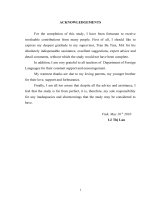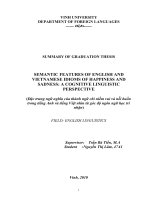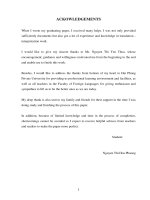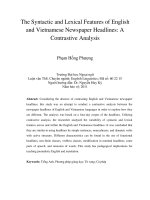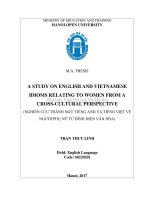Semantic features of English and Vietnamese idioms relating to education
Bạn đang xem bản rút gọn của tài liệu. Xem và tải ngay bản đầy đủ của tài liệu tại đây (266.9 KB, 10 trang )
SEMANTIC FEATURES OF ENGLISH AND
VIETNAMESE IDIOMS RELATING TO EDUCATION
Nguyen Thi Kim Phuong1
Abstract: Idioms express concepts and ideas whose meaning is not elicited from
the individual words. Idioms make the way of speaking and writing short, concise, visual,
and persuasive. They help speakers or writers communicate more successfully and
make languages more interesting, but it is not easy to master or use them appropriately.
Therefore, it is necessary to do an investigation into idioms in English and Vietnamese.
The paper is based on descriptive and comparative methods in contrastive analysis of 400
idioms relating to education to find out semantic features in terms of simile, metaphor,
metonymy. At the same time, the findings reveals some similarities and differences
between English and Vietnamese idioms relating to education. Hopefully, the paper can
help English learners and users with more effective performance in communication.
Key words: education idioms, semantic features, semantic fields, simile, metaphor,
metonymy.
1. Introduction
English becomes more and more important and necessary in the world, Vietnam
included; therefore, it becomes universalized at all grades of schooling in Vietnam.
Vocabulary is one of the essential aspects of language that all students are required to
achieve. Among them is the knowledge of idioms. The number of idioms referring to
education, i.e. teaching, learning, and examination, is quite large and they are rather
pervasive in daily language.
Students often face difficulties in using idioms when they access to English
materials because idioms contain not only literal meanings but also figurative and
expressive ones. They are an integral part of a language and they make the language
more beautiful and more dynamic. However, students find it really hard to understand
idioms because their meanings cannot often be deduced from the individual components,
which is a concern of many researchers. In fact, there have so far been several studies of
idioms, such as animals idioms by Pham Thi To Nhu (1998), human body parts idioms
by Nguyen Thi Hiep (2001), family idioms by Tran Ngoc Que Chau (2010), etc. Yet, a
comparison between English and Vietnamese idioms of education has not been carried
out. So, I would like to study semantic features of idioms relating to education in
English and Vietnamese by using descriptive and comparative methods to analyze 400
idioms relating to education from dictionaries of idioms in both languages. It is done in
hope of making a small contribution to helping students of English as well as Vietnamese
people who learn English and who are interested in idioms improve their vocabulary,
especially the knowledge of education idioms.
2. Content
1. MA., Quang Nam University
83
SEMANTIC FEATURES OF ENGLISH AND VIETNAMESE IDIOMS RELATING...
2.1. Definition of idioms relating to education
According to Longman Dictionary of English Language and Culture, an idiom
is “a fixed phrase that has its own special meanings and it is impossible to guess the
meanings from separated words". Similarly, Crowder [2] defines an idiom as “a phrase
whose meaning is difficult or sometimes impossible to guess by looking at the individual
words it contains”. That is, a group of words with set meanings that cannot be calculated
by adding up the separate meaning not deducible from those of the separate words [1], or
an expression the meaning of which cannot be inferred from the meaning of its parts [3].
In the same vein in Vietnamese, Hoàng Văn Hành [8] defines an idiom as “a stable word
group with a solid formation and structure, and a complete and figurative meaning, used
in everyday communication, especially in spoken language”. For example
"cá vượt Vũ Môn" is used to indicate a student who passes the exams.
hard.
"cần công kiệm học" is used to refer to a person that both has to study and work
Idioms do not give comments, experiences, a moral lesson, advice that make
idioms aesthetic not educated, that is the reason why an idiom does not become a literary
work – idioms belong to the language. Therefore, idioms do not bring about the full
understanding about lives and any lessons of the people’s relationships in the society.
As education is a process of teaching, training and learning, especially in schools
and colleges to improve knowledge and develop skills, Idioms Relating to Education
(IsE) is concerning the process of teaching, training and learning, such as “burning the
midnight oil” or “ra rả như cuốc kêu”.
2.2. Semantic features
Lexical meaning of an idiom follows a private rule. Every idiom has a complete
meaning as a set block generalized by all its forming elements. Although an idiom is
a combination of words, they are not the combination of the meaning of each element
forming it. For instance, the idiom "get a first" means to obtain a first-class honor
degree on graduation at a university.
Transference of meaning (those are simile, metaphor, metonymy) is the most
important expression of an idiom. Specific image is used to express as the symbol of
characters, qualities, activities, etc.
2.2.1. Simile
A simile is a figure of speech that indirectly compares two different things by
employing the words "like", "as", or "than" [11].
For examples:
- He smokes like a chimney.
- This exercise is as easy as pie.
- He is larger than life.
2.2.2. Metaphor
84
NGUYEN THI KIM PHUONG
Nguyễn Hòa [6] defines metaphor as the transference of meaning (name) from one
thing to another based on similarity between these two things.
Ellis, R. and Barkhuizen, G. state that: "A metaphor consists of a comparison
between two dissimilar notions where one notion is to be understood in terms of the
other notion." We can see that metaphor is an expression that describes a person or object
by referring to something that is considered having similar characteristics.
For examples:
- Bob is a couch potato.
2.2.3. Metonymy
Metonymy is based on a type of relation between the dictionary and contextual
meaning, a relation based on not only on affinity but also on some kinds of association
connecting the two concepts which these meaning represent.
Nguyễn Hòa [6] defines "Metonymy is the transference of meaning from one
object to another based on contiguity of notions."
For examples:
- I have three mouths to feed. (“mouth” refers to “a person”)
2.3. Semantic features of English and Vietnamese idioms relating to education
2.3.1. Transference of meaning of IsE in English and Vietnamese
2.3.1.1. Simile
Simile is a direct and expressed comparison between two things essentially unlike
each other, but resembling each other in at least one way. It is a device used to compare
an unfamiliar thing (to be explained) to some familiar things (an object, event, process,
etc.) known to the listener and the reader. Simile is the way to express an idea clearly,
concretely and lively [10]. It is a very common stylistic device and is frequently used in
idioms. We can find out some examples of IsE using simile as a stylistic device such as:
as easy as ABC, as easy as pie, as easy as falling off a log, etc.
(1) Learning how to use a computer was as easy as ABC for the children.
[Oxford Idioms Dictionary for learners of English (2010), Oxford University Press]
By using simile "as easy as ABC" in this idiom, the writer wants to refer to
something very easy to learn or to do.
In Vietnamese, a simile always employs the word "như, (chẳng) bằng", for
example: chữ như cua bò; dốt như bò; như rồng bay phượng múa; quấy như quỷ quấy
nhà chay; ra rả như cuốc kêu; chữ như trấu trát; hay chữ chẳng bằng dữ đòn; học như
gà đá vách; etc.
(2) "... phản đối ăn sống nuốt tươi văn hóa của người, học người như vẹt hoặc lắp
văn hóa của người vào hồn cảnh nước mình như máy, không đếm xỉa đến đặc điểm và
điều kiện đặc biệt của đất nước...." [Nguyễn Lân (1997), Từ điển thành ngữ và tục ngữ
Việt Nam, Nxb. Khoa học xã hội, Hà Nội]
85
SEMANTIC FEATURES OF ENGLISH AND VIETNAMESE IDIOMS RELATING...
The idiom "học như vẹt" in example (2) is used to describe someone who learns
something by heart but he/she doesn't understand it.
2.3.1.2. Metaphor
A metaphor is an imaginative way of comparing something to something else
which is the same in a particular way. If one thing is a metaphor for another, it is intended
or regarded as a symbol of it [5]. Metaphor is seen not just as a linguistic embellishment,
but also as a primary means by which people make sense of the world around them.
Therefore, it is unsurprising that metaphor is mainly used in the meaning transfer of
idioms.
English IsE contain metaphor such as with flying colours, at home, keep your
nose to the grindstone, make a pig's ear (out) of sth, watch your mouth/ tongue, (still)
wet behind the ears, hit the books, etc. Let us analyze some examples of IsE to illustrate
their application.
(3) After playing all weekend I had to hit the books on Sunday evening.
[ (February 03, 2011]
(4) He's a young teacher, still wet behind the ears.
[Từ điển thành ngữ Anh - Anh - Việt, NXB Tổng hợp TP HCM]
Seen in (3), the verb "hit" which means "to touch sb/sth with force" and the noun
"books" with the literal meaning of "a set of printed pages that are fastened inside a
cover so that you can turn them and read them " but in the idiom "hit the books " implies
a learner who begins to study in a serious and determined way. Considering the example
(4), the literal meaning of the idiom "wet behind the ears" is "the ears are still wet" but
its metaphorical meaning that "someone who is young and especially with very little
experience in teaching".
In Vietnamese, metaphor is also used in many IsE such as đem chuông đi đấm
nước người, nấu sử sôi kinh, bán cháo phổi, giẫm vỏ chuối, soi kinh bóng quế, gõ
đầu trẻ, etc.
Let us look at some examples.
(5) Như Tự, Như Thuật phải hàng mười năm nấu sử sôi kinh ở bậc phổ thông và
ba bốn năm mài đũng quần ở trường Đại Học.
[Ma Văn Kháng (2000), Đám cưới khơng có giấy giá thú, Nxb. Văn học]
"Nấu" and "sôi" are action and process of cooking, however, this meaning
of the idiom in (5) does not express these processes. They show the transferring of its
metaphorical meanings to lead this idiom to an abstract meaning as someone who is
laborious and studious in their learning.
2.3.1.3. Metonymy
Metonymy is defined as a "figure in which one word is substituted for another
on the basis of some material, causal, or conceptual relation [6]. For Nunberg (1978,
1979), metonymy is a case of "deferred reference", in which a speaker uses a description
86
NGUYEN THI KIM PHUONG
of A and succeeds in referring B. The following are some expressions of metonymy in
Vietnamese as hội Long Vân, Cửa Khổng sân Trình, áo gấm về làng.
(6) "Sau bấy nhiêu năm đèn sách, bây giờ được áo gấm về làng, kể cũng bõ."
dục]
[Nguyễn Trọng Khánh (2008), Sổ tay thành ngữ, tục ngữ Tiếng Việt, Nxb. Giáo
In (6) "áo gấm" refers to learners who pass the exams with flying colours.
In English we also have some idioms forming by the means of metonymy such as
cow in cow college.
(7) “The closet approximation to a cow college in the UC (University of California)
system, University of California- Davis’ agricultural programs are rated second in the
world in U.S. News Global Universities Rankings.
[ 03, 2011]
Seen in (7), idiom "cow college" indicates colleges and universities that train fields
in agriculture or refers to schools located in remote and isolated areas.
2.4. Semantic fields of English and Vietnamese idioms relating to education
2.4.1. School and Class
In Oxford Advanced Learner’s Dictionary, the noun "school" has some following
meanings: a place where children go to be educated; the process of learning in a school;
the time during your life when you go to a school; the time during the day when children
are working in a school; all the children or students and the teachers in a school, etc. Due
to the lexical nature of IsE, the idioms of expressing School and Class is much bigger in
number in English than in Vietnamese. We can find out many idioms expressing School
and Class as follows.
(8) Several of the company executives had gone to an Ivy League school.
[ (February 03, 2011]
The idiom "Ivy League" denotes a small group of older and famous eastern United
States colleges and universities such as Harvard, Yale and Princeton.
(9) "Trí thức của nước ta cũng có một số lớn được đào tạo ở cửa Khổng sân
Trình." [Nguyễn Lực, (2001), Thành ngữ tiếng Việt, Nxb. Thanh niên]
As in (9) "Khổng" refers to Khổng Tử, "Trình" refers to Trình Tử (Trình Di) who
are typical people of confucianism. The idiom "cửa Khổng sân Trình" is a place that
instructs confucianism and forms Confucian scholars in the old day.
2.4.2. Examinations
As we know examination is an act of examining, or state of being examined; a
careful search, investigation, or inquiry; scrutiny by study or experiment. In other words,
that is a process prescribed or assigned for test qualification; as, the examination of a
learner, or of a candidate for admission to the ministry. Therefore, there is always success
or failure in the examination. We can find some English idioms expressing examination
such as make the grade, pit your wits (against sb/sth), (earn/ get) straight A's (AmE),
87
SEMANTIC FEATURES OF ENGLISH AND VIETNAMESE IDIOMS RELATING...
put sb/sth to the test, come unstuck (BrE), below average, flunk out, etc. The examples
below manifest these idioms.
(10) She got straight A's in all her exams. [Oxford Idioms Dictionary for learners
of English (2010), Oxford University Press]
The idiom “got straight A'” means that learners get the best marks or grades in all
their classes. In (10) the idiom is about success in studying as well as in examination.
(11) She came unstuck in the last part of the exam. [Oxford Idioms Dictionary for
learners of English (2010), Oxford University Press]
Beside success in the exams, there is also fail. The idiom "come unstuck" in (11)
denotes being unsuccessful or failure of learners in the examination.
In Vietnam, examination plays a very important role in the society. Vietnamese
idioms also show success or failure of the learners in the examination, such as học tài thi
phận, học thành danh lập, bảng vàng bia đá, đua dại tranh khơn, vinh quy bái tổ, có
cơng đèn sách, cá chép hóa rồng, cá vượt Vũ Mơn, trượt vỏ chuối, kế thế đăng khoa,
lận đà lận đận, etc. Let us consider these following examples.
(12) "Ông nhận vế xướng, hứa lúc vinh quy sẽ đối, và rước nàng về luôn, đại đăng
khoa và tiểu đăng khoa một thể." [Trần Quốc Thịnh (2004), Danh nhân lịch sử kinh Bắc,
Nxb. Lao động Hà Nội]
(13) "Đến ngày vinh quy bái tổ, ông vào chùa làm lễ tạ ơn sư thầy đã có cơng rèn
dạy ơng thành người đức hạnh, tài giỏi để giúp nước."
[Tú Anh (2010), 101 truyện kể giáo dục bé, Nxb. Văn hóa thơng tin]
The idiom “đăng khoa" in (12) expresses getting a pass in the exam. The next
example also conveys the same meaning. Additionally, the idiom "vinh quy bái tổ" as in
(13) tells about learners in the old day passing the exam and became Doctors to whom
the King gave commendation with flags when they returned to their homeland to worship
their ancestors and were welcomed by their villagers.
Although learners try their best and work hard, they still fail the examination.
Therefore, the learners need to have lucky destiny to pass the exam. Let us see the
following example.
(14) "Tôi lại lo cho Hương: Em có đảm bảo chắc chắn đỗ khơng? Học tài thi phận
biết thế nào. Nhưng nếu có 10% số người dự thi đỗ, chắc là có em." [Nguyễn Lực,
(2001), Thành ngữ tiếng Việt, Nxb. Thanh niên]
The idiom "học tài thi phận" in (14) shows the good learners taking part in an
exam but not passing it because they were unlucky in spite of working hard.
2.4.3. Learners' personalities/ appearance
Learners' personality can be defined as a dynamic and organized set of characteristics
possessed by a person that uniquely influences his or her cognitions, motivations, and
behaviors in various situations. IsE in English and Vietnamese are used to express good
or bad personality of learners. Let us consider the following examples.
88
NGUYEN THI KIM PHUONG
(15) I sweated blood to get that essay finished on time.[Oxford Idioms Dictionary
for learners of English (2010), Oxford University Press]
In the idiom “sweet blood’, the word "blood" indicates to be hard working or
learning. The idiom "sweat blood" in (15) expresses that if learners make a great effort
in learning, they will get good marks. In other words, they must be diligent students.
Apart from diligence and intelligence of learners, there are also students who
study both ignorantly and very lazily. English idioms have expressions like that in the
following examples:
(16) Is she off school because she's ill, or is she play truant? [Từ điển thành ngữ
Anh - Anh - Việt, NXB Tổng hợp TP HCM]
Some typical idioms of learners' personality in Vietnamese are học hay cày giỏi,
học trước quên sau, chữ nhất bẻ làm đôi, chữ tác đánh chữ tộ, chữ tốt văn hay, dùi
mài kinh sử, khổ học khổ luyện, học một biết mười, thùng rỗng kêu to, etc. Some
examples below illustrate these idioms.
(17) "Kính xin bệ hạ rộng lịng cho thần được lui về một thời gian nữa để thần dụng
công dùi mài kinh sử văn chương đặng tinh tiến hơn nữa về sở học." [Kiều Văn (2002),
Giai thoại lịch sử Việt Nam, Nxb. Văn hóa thơng tin]
By using the idiom "dùi mài kinh sử", the author evokes the image of a learner
who is very industrious and hard in learning in order to become a well-versed person.
2.4.4. Methods/ Ways of teaching and learning
In this semantic field, a teaching- learning method is very necessary for both teachers
and learners. It comprises the principles and methods used for instruction. Commonly used
teaching-learning methods may include class participation, demonstration, recitation,
memorization, or combinations of these. The choice of an appropriate teaching-learning
method depends largely on the information or skill that is being taught, and it may also be
influenced by the attitude and enthusiasm of the students. We can consider the following
examples.
(18) He was brought up in a hard school which stood him in good stead later when
he explored the Antarctic. [Gulland, D. M. (1994), The Penguin Dictionary of English
Idioms, Penguin Group]
The idiom "a hard school" in this semantic field refers to a person who has a strict
training.
(19) Don't listen to him. Remember that he only learns something in parrotfashion. [Từ điển thành ngữ Anh - Anh - Việt, NXB Tổng hợp TP HCM]
As we know "parrot" is an animal which says what he says, but does not know
what he says. By using this idiom, the writer wants to denote if people who learn or
remember something without thinking about it or understanding what it means.
Besides the above idioms, some Vietnamese ones from this field can be found out
in the corpus such as học như vẹt/ học vẹt, đa thư loạn mục, miệng nói tay làm, ơn cố
89
SEMANTIC FEATURES OF ENGLISH AND VIETNAMESE IDIOMS RELATING...
tri tân, ra rả như cuốc kêu, tầm chương trích cú, ê à ề à, học như cuốc kêu mùa hè,
như rót vào tai, etc. We have some examples below.
(20) "Chỉ học thuộc lịng bài vở mà khơng chịu suy nghĩ vận dụng vào thực tiễn
cũng bằng học như vẹt." [Nguyễn Lực, (2001), Thành ngữ tiếng Việt, Nxb. Thanh niên]
Similar to English, Vietnamese idioms express learning ways with disparaging
attitude in such idiom as "học như vẹt", that is a learning way in which learners learn by
heart mechanically what others have said without understanding.
(21) "Các cụ đã có cái quan niệm như vậy thì học là chủ đề thực dụng cốt là trau
dồi cái nhân cách mình thế nào cho thể hi thánh hi hiền được, chớ không phải cốt lập
ra học thuyết để truyền cho đời vậy..." [Nguyễn Đơng Chí, Trần Văn Giáp (1970), Việt
Nam cổ văn học sử]
In Vietnam, according to the idea of Vietnamese people in the old days, when
learners' parents took their children to school, they often hoped that their children would
follow the sages' example such as Khổng Tử and his disciples.
(22) "Chiêu Vũ chỉ là hạng bạch diện thư sinh tầm chương trích cú, chỉ giỏi ăn
nói kiểu cách khéo léo nên được Chúa thượng thân thương, ông ta do vậy coi triều đình
như chỗ khơng người...." [Gia Khánh Định (2000), Hội đồng Biên tập Tổng Hợp Văn
học Việt Nam, Chương 9]
In the idiom, the verb "tầm" refers to find out or collect, "chương" indicates an
essay, "cú" refers a sentence. The idiom "tầm chương trích cú" expresses the way of
learning by Confucians in the old days. They do not pay attention to finding or collecting
the content, they only pick up old clichés.
2.5. Similarities and differences in semantic features of English and Vietnamese
idioms relating to education
2.5.1. Similarities
Idioms beautify the language and establish the characteristic style of each individual
language. Although the culture of two nations is different, both Vietnamese and English
express ideas and concepts in the same way. The idioms earn parrot-fashion/ learn by
rote and the blind leading the blind in English, for example, have their equivalent in
Vietnamese học như vẹt and thằng mù dẫn dắt thằng mù respectively.
Besides both English and Vietnamese idioms referring to education have the
common semantic fields and sub-fields such as School and Class, Examination, Methods/
Ways of Teaching and Learning.
What is more, both languages use some stylistic devices such as simile, metaphor,
metonymy to make a colorful and interesting picture in idioms referring to education.
2.5.2. Differences
Language is part of culture and vice versa, so the ways of expressing ideas and
thoughts, which is usually influenced by culture and custom, through idioms in English
and Vietnamese are different.
90
NGUYEN THI KIM PHUONG
The first difference lies in the fact that English civilization is mainly originated
from the civilization of ancient Greece and Rome in the Mediterranean. Meanwhile,
Vietnam is a nation which spends a long and hard history. Especially, the feudalism has a
great influence on the development of the country as well as on the Vietnamese language.
Living in such a society, Vietnamese people are impacted by confucianism education.
This feature is expressed in a majority of Vietnamese idioms in general and idioms of
education in particular. For examples, nấu sử sôi kinh, hi thánh hi hiền, cửa Khổng
sân Trình, tầm chương trích cú, vinh quy bái tổ, áo gấm về làng, which are not found
in English.
The second difference is that there are some Vietnamese idioms of which origins
come from folk stories such as ăn vóc học hay, cá vượt Vũ Mơn, dốt có đi (dốt có
chi), etc while no idioms of this case can be discovered in English. Idiom “dốt có
đi” appeared in exams under the feudalism. At first, the idiom only decried few people
who were not so ignorant. They were also people who passed the exams, but after exams,
they were gathered and had a formal interview with the King. They were arranged from
the highest score to the lowest and wore clothes which the King rewarded. The person
who had the lowest position wore long band hat (mũ có đai dài) like “tail”, so “có đi”
was stuck for them. Nowadays, idiom “dốt có đi” is widely used in Vietnamese daily
conversations to denote anyone who is ignorant.
One more difference is that Vietnam has the cultural tradition of the wet rice
production. Therefore, animals have strong attachment to Vietnamese daily life, not
exiting in English IsE. For examples, chữ như trấu trát, chữ như gà bới, học như gà đá
vách, nước đỗ đầu vịt, giẫm/ trượt vỏ chuối.
3. Conclusion
The paper has investigated semantics features of IsE in English and Vietnamese
as well as showed the similarities and differences between them. As we have analyzed,
there is a wide variety of meanings of IsE in English and Vietnamese. Semantically,
English and Vietnamese idioms referring to education express their meanings via means
of semantic transfer such as simile, metaphor, and metonymy. Metaphor is used as the
main stylistic device in most of idioms in English as well as in Vietnamese such as with
flying colours, hit the books, (still) wet behind the ears and also nấu sử sôi kinh, bán
cháo phổi, giẫm vỏ chuối,, etc in Vietnamese. Metonymy is used in some idioms such
as cow college in English and we have áo gấm về làng in Vietnamese. Simile is used
in some idioms such as as easy as ABC in English and học như vẹt in Vietnamese.
Besides, the figurative and concrete characteristics of English and Vietnamese IsE
are also presented in four fields, including school and class, examinations, learners'
personalities/ appearance and methods/ ways of teaching and learning. It is hoped that
the findings may be implied in learning and teaching English and Vietnamese as second
or foreign languages, helping language learners achieve their goals of communication.
91
SEMANTIC FEATURES OF ENGLISH AND VIETNAMESE IDIOMS RELATING...
REFERENCES
[1] Cowie, A. P. et al (1994), Oxford Dictionary of English Idioms, Oxford University
Press.
[2] Crowder, J. T. (1995), Advanced Learner's Dictionary, Oxford University Press.
[3] Cruse, D. A. (1986), Lexical Semantics, Cambridge University Press.
[4] Della, S. et al (1987), Longman Dictionary of Contemporary English,
Group UK Limited.
Longman
[5]Fromkin, V. Blair. D. and Collins. P (1999), An Introduction to Language, London:
Harcourt.
[6] Nguyễn Hòa (2001), Introduction to Semantics, Vietnamese National University,
Hanoi.
[7] Seidl, J. & Mc Mordie, W. (1978), English Idioms and How to Use Them, Cambridge
University Press.
[8] Hoàng Văn Hành, Kể chuyện Thành ngữ - Tục ngữ, Nxb. Văn hóa Sài Gịn.
[9] Hồng Phê (1997), Từ Điển Tiếng Việt, Nxb. Đà Nẵng.
[10] Nguyễn Hữu Quỳnh (1996), Tiếng Việt hiện đại, Trung tâm biên soạn từ điển Bách
khoa Việt Nam.
NHỮNG ĐẶC ĐIỂM NGỮ NGHĨA CỦA THÀNH NGỮ TIẾNG ANH VÀ
TIẾNG VIỆT LIÊN QUAN ĐẾN GIÁO DỤC
NGUYỄN THỊ KIM PHƯỢNG
Trường Đại học Quảng Nam
Tóm tắt: Thành ngữ thể hiện các khái niệm và ý tưởng mà ý nghĩa của nó không
được gợi ra từ các từ riêng lẻ. Thành ngữ giúp cho cách nói và cách viết vừa ngắn gọn,
súc tích, vừa gợi hình và có sức thuyết phục. Chúng giúp người nói hoặc người viết giao
tiếp thành cơng hơn và làm cho ngôn ngữ trở nên thú vị hơn, nhưng không dễ để nắm
vững và sử dụng chúng một cách hợp lý. Vì vậy, cần phải thực hiện một cuộc điều tra về
các thành ngữ trong tiếng Anh và tiếng Việt. Bài báo dựa trên các phương pháp mô tả và
so sánh trong phân tích đối chiếu với khoảng 400 thành ngữ liên quan đến giáo dục để
tìm ra những nét đặc trưng về ngữ nghĩa trong các phép so sánh, ẩn dụ, hoán dụ. Đồng
thời, kết quả cho thấy một số điểm giống và khác nhau giữa những thành ngữ tiếng Anh
và tiếng Việt liên quan đến giáo dục. Hy vọng bài báo có thể giúp người học và người sử
dụng tiếng Anh hiệu quả hơn trong giao tiếp.
Từ khóa: thành ngữ giáo dục, đặc điểm ngữ nghĩa, phạm vi ngữ nghĩa, so sánh,
ẩn dụ, hoán dụ.
92


